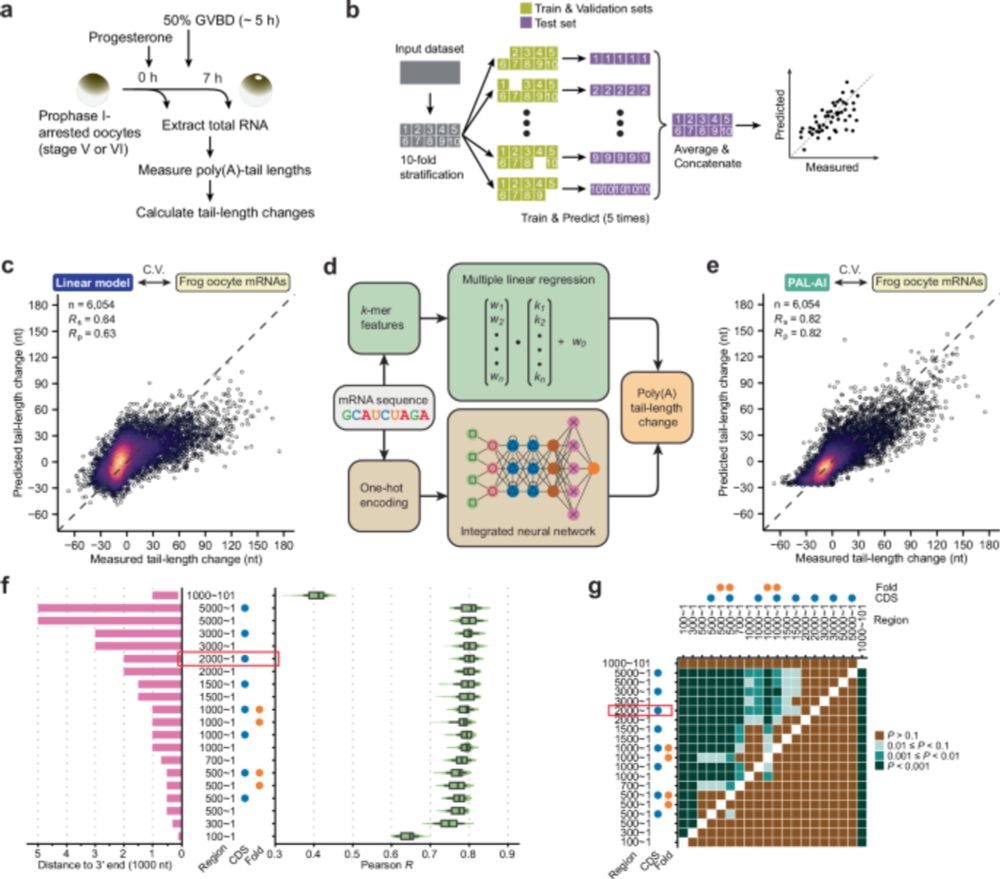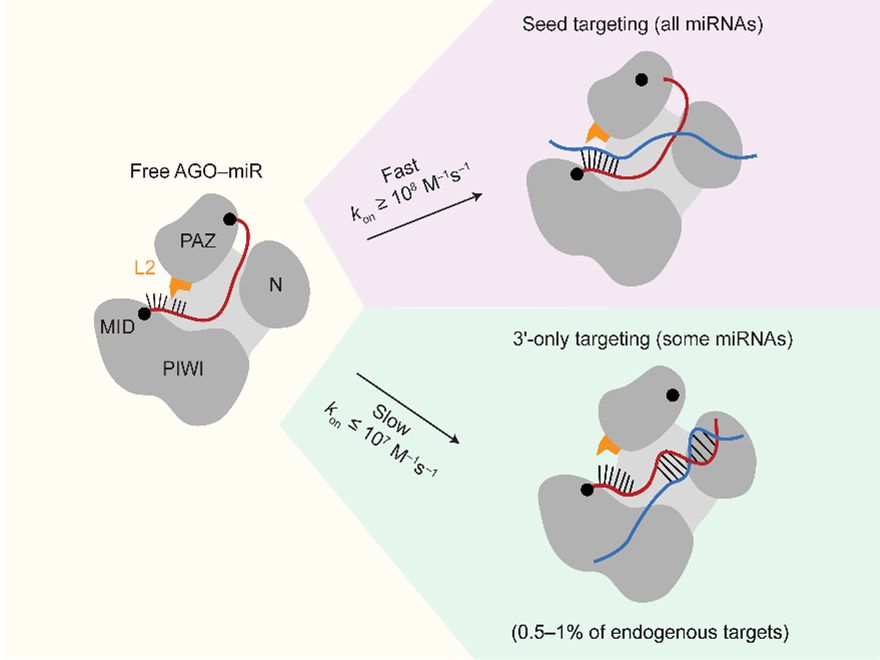
David Bartel's Lab
@bartellab.bsky.social
David Bartel's lab @WhiteheadInst @MIT @HHMI | microRNAs, mRNAs, and other RNAs
Reposted by David Bartel's Lab
From an accidental discovery of hidden biology to a new framework to understanding and diagnosing rare disease. Thrilled to share the most recent work from our lab and the amazing Jimmy Ly.
wi.mit.edu/news/alterna...
wi.mit.edu/news/alterna...

Alternate proteins from the same gene contribute differently to health and rare disease | Whitehead Institute
Iain Cheeseman and colleagues reveal the underappreciated role of single genes producing multiple proteins in atypical presentations of rare disease, and present case studies of affected patients thro...
wi.mit.edu
November 7, 2025 at 4:14 PM
From an accidental discovery of hidden biology to a new framework to understanding and diagnosing rare disease. Thrilled to share the most recent work from our lab and the amazing Jimmy Ly.
wi.mit.edu/news/alterna...
wi.mit.edu/news/alterna...
Check out the latest work from our lab, led by Daniel Lin and Lara Elcavage: www.biorxiv.org/content/10.1... (1/3)

mRNA 3′ UTRs direct microRNA degradation to participate in imprinted gene networks and regulate growth
MicroRNAs direct downregulation of target mRNAs. Sometimes, however, this regulatory paradigm inverts, and a target RNA triggers the degradation of a microRNA. This target-directed microRNA degradatio...
www.biorxiv.org
November 7, 2025 at 6:33 PM
Check out the latest work from our lab, led by Daniel Lin and Lara Elcavage: www.biorxiv.org/content/10.1... (1/3)
Check out the latest work from our lab, led by Arash Latifkar @ara-latifkar.bsky.social , www.biorxiv.org/content/10.1...

mRNA poly(A)-tail length is a battleground for coronavirus–host competition
Most eukaryotic mRNAs contain a poly(A) tail, which in post-embryonic cells enhances their stability. Many cytoplasmic RNA viruses also harbor poly(A) tails on their genomic RNA and mRNAs. Here, we re...
www.biorxiv.org
October 13, 2025 at 7:44 PM
Check out the latest work from our lab, led by Arash Latifkar @ara-latifkar.bsky.social , www.biorxiv.org/content/10.1...
Check out the latest work from Jordan Ray (@jordanray.bsky.social), a collaboration between our lab and David Sabatini’s lab. www.biorxiv.org/content/10.1... (1/2)

Lysosomal RNA profiling reveals targeting of specific types of RNAs for degradation
Autophagy targets a wide variety of substrates for degradation within lysosomes. While lysosomes are known to possess RNase activity, the role of lysosomal RNA degradation in post-transcriptional gene...
www.biorxiv.org
September 11, 2025 at 1:58 PM
Check out the latest work from Jordan Ray (@jordanray.bsky.social), a collaboration between our lab and David Sabatini’s lab. www.biorxiv.org/content/10.1... (1/2)
Reposted by David Bartel's Lab
Delighted to present our second paper of the year. This one explores the molecular mechanism of TTP, a key post-transcriptional regulator of AU-rich mRNAs. Work led and coordinated by @filippekovic.bsky.social, in collaboration with Perry Blackshear.
www.nature.com/articles/s41...
www.nature.com/articles/s41...

Multivalent interactions with CCR4–NOT and PABPC1 determine mRNA repression efficiency by tristetraprolin - Nature Communications
Deadenylation leads to mRNA decay, with PABPC1 protecting the poly(A) tail, while tristetraprolin and CCR4–NOT promote deadenylation. Here, the authors describe how these three proteins interact to re...
www.nature.com
August 13, 2025 at 5:32 PM
Delighted to present our second paper of the year. This one explores the molecular mechanism of TTP, a key post-transcriptional regulator of AU-rich mRNAs. Work led and coordinated by @filippekovic.bsky.social, in collaboration with Perry Blackshear.
www.nature.com/articles/s41...
www.nature.com/articles/s41...
Check out the latest study from our lab, led by Coffee Xiang (@coffeebond007.bsky.social) www.nature.com/articles/s41... (1/2)

PAL-AI reveals genetic determinants that control poly(A)-tail length during oocyte maturation, with relevance to human fertility - Nature Communications
Gene regulation in oocytes relies heavily on poly(A) tail-length changes. Here, the authors develop PAL-AI, a neural network model that predicts tail-length changes, identifies regulatory motifs, and ...
www.nature.com
August 2, 2025 at 3:00 PM
Check out the latest study from our lab, led by Coffee Xiang (@coffeebond007.bsky.social) www.nature.com/articles/s41... (1/2)
Reposted by David Bartel's Lab
New preprint! We solve a mystery you didn't know existed. Mitotic cells lack new transcription but require ongoing translation. Interphase mRNA half life is only 2-4 hrs. So how do cells arrest in mitosis for hours without depleting their transcriptomes?
www.biorxiv.org/content/10.1...
www.biorxiv.org/content/10.1...

Global inhibition of deadenylation stabilizes the transcriptome in mitotic cells
In the presence of cell division errors, mammalian cells can pause in mitosis for tens of hours with little to no transcription, while still requiring continued translation for viability. These unique...
www.biorxiv.org
July 23, 2025 at 10:57 AM
New preprint! We solve a mystery you didn't know existed. Mitotic cells lack new transcription but require ongoing translation. Interphase mRNA half life is only 2-4 hrs. So how do cells arrest in mitosis for hours without depleting their transcriptomes?
www.biorxiv.org/content/10.1...
www.biorxiv.org/content/10.1...
Don’t miss this Q&A with Dr. Michelle Frank (@michelle-frank.bsky.social), an awesome postdoc in our lab!
Our latest Postdoc Q&A features Michelle Frank from the Bartel lab. Michelle is interested in how the brain balances the ability to learn new things with the need for maintaining stable connections. wi.mit.edu/news/meet-wh... #WhiteheadPostdocProfiles @bartellab.bsky.social

April 5, 2025 at 7:51 PM
Don’t miss this Q&A with Dr. Michelle Frank (@michelle-frank.bsky.social), an awesome postdoc in our lab!
Check out the latest study from our lab, led by @mhall98.bsky.social :
www.biorxiv.org/content/10.1... (1/2)
www.biorxiv.org/content/10.1... (1/2)

March 15, 2025 at 12:36 AM
Check out the latest study from our lab, led by @mhall98.bsky.social :
www.biorxiv.org/content/10.1... (1/2)
www.biorxiv.org/content/10.1... (1/2)
Reposted by David Bartel's Lab
Happy 2025! Excited to finally share our published slicing structure of human AGO2, the catalytic structure for RNAi by siRNAs and miRNAs. This was an amazing collab effort between @voslab.org and @bartellab.bsky.social with @amohamed98.bsky.social
Our collaborative AGO2 work with @bartellab.bsky.social is published! Abdallah and Peter used cryo-EM and biochemistry to determine the structure of AGO2 in a slicing competent conformation with a fully paired RNA. Read more about it here: tinyurl.com/AGO2-slicing

The structural basis for RNA slicing by human Argonaute2
Mohamed et al. report the cryoelectron microscopy structure of human AGO2 with fully paired guide RNA. Their analysis reveals the structural basis for the slicing activity that drives RNAi, showing that the slicing-competent conformation is achieved by domain movements and RNA-protein contacts distinct from those of conformational intermediates and prokaryotic homologs.
tinyurl.com
January 1, 2025 at 6:31 PM
Happy 2025! Excited to finally share our published slicing structure of human AGO2, the catalytic structure for RNAi by siRNAs and miRNAs. This was an amazing collab effort between @voslab.org and @bartellab.bsky.social with @amohamed98.bsky.social
Check out our latest paper in collaboration with @voslab.org on the cryo-EM structure of slicing by human AGO2: tinyurl.com/AGO2-slicing
January 3, 2025 at 2:18 AM
Check out our latest paper in collaboration with @voslab.org on the cryo-EM structure of slicing by human AGO2: tinyurl.com/AGO2-slicing
Bartel Lab bids a fond farewell to our incredible lab manager, Asia Stefano. Wishing you all the best on your new adventures in the Rocky Mountains, Asia—thank you for the amazing time we shared together!

December 18, 2024 at 10:24 PM
Bartel Lab bids a fond farewell to our incredible lab manager, Asia Stefano. Wishing you all the best on your new adventures in the Rocky Mountains, Asia—thank you for the amazing time we shared together!

